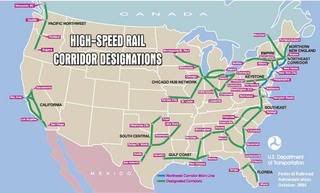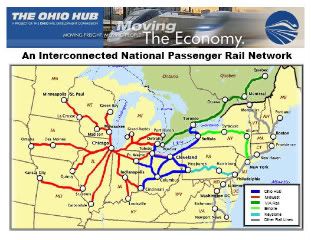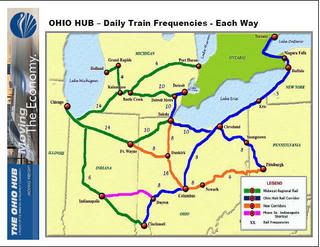Vertical Wind Turbines Put New Spin on Advertising by Triple Pundit (MatteR Network)
BBC Covers Peak Oil: A Farm for the Future by Chris Vernon (The Oil Drum)
Ford Sneaks Up On Electric Car Future (HybridCars)
Indian Cities Recognize that Solving the Climate Crisis Doesn’t Involve Promoting Automobiles by Yonah Freemark (TransportPolitic)
Populist movements don't build themselves ...
... It doesn't matter what the "horse race" outcome of the campaign is, if we fight the campaign. Fighting it, we learn how to fight. Learning how to fight political battles, we become citizens again. Becoming citizens again, we reclaim the Republic that lies dormant beneath the bread and circuses of modern American society.
- Picture Credit: David Leeson (#8)
Friday, February 20, 2009
Saturday, February 14, 2009
You're From Ohio, You Idiot, Don't Screw With Our Train
Crossposted: Docudharma, ProgressiveBlue, The Economic Populist, and also at Agent Orange.
Burning the Midnight Oil for a Brawny Recovery
(h/t Matthew Yglesias)
Now, lets look at the Federally Designated Corridors -- and you have to gave a designated corridor to get any of the $8b.

Yup, no corridor to Vegas. Oh, and what's that we see ... two, count 'em TWO corridors through Ohio ... Cleveland to Chicago and Cleveland / Columbus / Dayton / Cincinnati.
Indeed, the Triple-C route ... which at present has no interurban rail service, because back in 1960, Columbus was a little cow town of 300,000, and its growth to a metro area of 1m+ happened during Amtrak's long struggle to avoid the ax ... goes right past Boehner's District.
And look more closely, at the full fledged Ohio Hub:


... if we can roll out the system, Boehner's constituents will be able to catch a train in outer northern Cincinnati or Dayton and get to Philadelphia, or New York, or DC. Now, y'all who live in big metro areas might think that's a long trip ... but the reality for someone living in Boehner's district heading to one of those destinations is normally a much longer drive to an airport, then a puddle jumper to a hub, then a flight to the destination.
And getting "shovel ready" projects on the corridor is straightforward. Since the Ohio Hub is designed along existing rail rights of way, there are few alignment headaches to hammer out. And since it is targeted to being a 110mph Rapid Rail system, one of the essential projects required will be upgrading crossings to the quad gates, speed-sensitive train detectors, and improved signaling to allow crossing at 110mph.
That is, a large number of small upgrade projects, spread across the state. Including projects just east of Boehner's own district, therefore certain to be employing some of Boehner's own constituents.
Look, Boehner -- can I call you John? No? How about Clueless Dick, would that be alright? -- you are trying to undermine work for your own constituents, to get a substantial down payment on a transport system that will, one day, be highly valued by your constituents.
When they do the redistricting, I hope they take your "safe" Republican district and do to you what you SOB's did to Franklin County Democrats after the 2000 Census. I just want to see you defending your fight against jobs and economic opportunity in Southwestern Ohio in a swing district.
Now that would be Change that I would Really Truly Believe In!
Burning the Midnight Oil for a Brawny Recovery
"Tell me how spending $8 billion,"asked House Minority Leader John Boehner (R-OH) on the floor,
"in this bill to have a high-speed rail line between Los Angeles and Las Vegas is going to help the construction worker in my district."
(h/t Matthew Yglesias)
Now, lets look at the Federally Designated Corridors -- and you have to gave a designated corridor to get any of the $8b.

Yup, no corridor to Vegas. Oh, and what's that we see ... two, count 'em TWO corridors through Ohio ... Cleveland to Chicago and Cleveland / Columbus / Dayton / Cincinnati.
Indeed, the Triple-C route ... which at present has no interurban rail service, because back in 1960, Columbus was a little cow town of 300,000, and its growth to a metro area of 1m+ happened during Amtrak's long struggle to avoid the ax ... goes right past Boehner's District.
And look more closely, at the full fledged Ohio Hub:


... if we can roll out the system, Boehner's constituents will be able to catch a train in outer northern Cincinnati or Dayton and get to Philadelphia, or New York, or DC. Now, y'all who live in big metro areas might think that's a long trip ... but the reality for someone living in Boehner's district heading to one of those destinations is normally a much longer drive to an airport, then a puddle jumper to a hub, then a flight to the destination.
And getting "shovel ready" projects on the corridor is straightforward. Since the Ohio Hub is designed along existing rail rights of way, there are few alignment headaches to hammer out. And since it is targeted to being a 110mph Rapid Rail system, one of the essential projects required will be upgrading crossings to the quad gates, speed-sensitive train detectors, and improved signaling to allow crossing at 110mph.
That is, a large number of small upgrade projects, spread across the state. Including projects just east of Boehner's own district, therefore certain to be employing some of Boehner's own constituents.
Look, Boehner -- can I call you John? No? How about Clueless Dick, would that be alright? -- you are trying to undermine work for your own constituents, to get a substantial down payment on a transport system that will, one day, be highly valued by your constituents.
When they do the redistricting, I hope they take your "safe" Republican district and do to you what you SOB's did to Franklin County Democrats after the 2000 Census. I just want to see you defending your fight against jobs and economic opportunity in Southwestern Ohio in a swing district.
Now that would be Change that I would Really Truly Believe In!
The Broken Political Economy of the Bail-Out
Burning the Midnight Oil for a Brawny Recovery
Joseph Stiglitz on the Political Economy of the Bail-Out: Who's At the Table?
Or as your humble correspondent wrote at Obama's Emergency Banking Act of 2009 (European Tribune):
Joseph Stiglitz on the Political Economy of the Bail-Out: Who's At the Table?
Or as your humble correspondent wrote at Obama's Emergency Banking Act of 2009 (European Tribune):
One thing that becomes clear from the ...
... Geithner proposal is who the "them" is ... if the banks turn out to be unable to service their debt and senior preferred shares, then the recourse is to convert senior preferred shares to common shares to dilute the equity of the shareholders.
The solution to not having enough money to pull toxic assets out of the system to get enough of the toxic assets out of the hands of all of the big money center banks to ensure that they can continue to act as big money center banks ... rather than the alternate view of the task at hand, in the terms of ensuring a sufficient subsystem of non-zombie banks to be able to provide the finance sector services required by Main Street if there is a recovery in 2010 or 2011 ... is to subsidize the acquisition of toxic assets by speculators.
The "them" he is not giving up is the senior management and overpaid specialists for the big money center banks. And, seemingly, he continues to view a main function of the banking system to act as a middleman between financial individuals and financial markets, with hundreds of billions of dollars under his direct control to be aimed at socializing losses so that the process can continue.
IOW, the people that have to be the main target of any hidden nationalization of the banking system aimed at ensuring that what was once its primary function (but which it "outgrew" over the past thirty years in the "market centric" Anglo disease countries) is not sacrificed to acting as a middleman between wealthy individuals and financial markets.
However, bank shareholders ... many of them, indirectly, small individuals and small business via the pension funds, insurance companies and other institutional investors providing "Main Street" financial services ... well, if it goes pear shaped, they can take a haircut. You gotta have your priorities, after all.
Monday, February 9, 2009
Getting the Bail-Out Right: Stimulus versus Bail-Out and Debt versus Leverage
Crossposted at: Docudharma, ProgressiveBlue, The Economic Populist, Congress Matters, Agent Orange.
Burning the Midnight Oil for the Next American Revolution
 Jerome a Paris at the European Tribune focuses in on the central problem of the Financial crisis, and therefore the central problem of the Bail-Out:
Jerome a Paris at the European Tribune focuses in on the central problem of the Financial crisis, and therefore the central problem of the Bail-Out:
 So leverage is the central problem ... or rather, the central problems:
So leverage is the central problem ... or rather, the central problems:
Now, there is lots of government spending that increases our leverage, and lots that reduces our leverage. Investing in Energy Independent Transport, Housing and Agriculture, for example, would be "debt" with a net pay-off for the economy, and therefore is an increase in our debt totals that would, over time, reduce our net debt burden.
On other other hand, subsidizing people going into debt to buy houses and cars - there's little long term benefit to point to there. Those are programs that only work as short-term stimulus by making the long term problem worse.
And handing out tax cuts ... especially tax cuts to those who are trying to convert their fantasy wealth into real world wealth at the expense of the rest of us ... has less than $1 stimulus impact for each $1 in handouts to the rich, so its clearly an increase in leverage.
However, these are just finger exercises, getting warmed up for the big looming fight to convert fantasy wealth into real wealth ... the fight coming over TARP 3.0.
Now is the Time to Organize for Tarp 3.0
The Washington Post (h/t Kagro X at Congress Matters) lets us know that Tarp 2.0 is going to be pursued within the limits of the $350b already appropriated for the bail-out. And it included the note that:
And someone in putting together Tarp 2.0 has been reading over my shoulder. That is:
And the tougher conditions?
A Beautiful Financial Rescue Plan on 10 October, 2008:
Today's announcement:
A Beautiful Financial Rescue Plan on 10 October, 2008:
But of course, its a bit like its cherry-pit picked, in that some of the sweetest parts of the Beautiful Rescue Package were left behind, including the Trustee holding onto the Senior Preferred Shares, receiving, in ordinary times, a stream of income allowing it to retire the bonds used to finance the package ... and the strings attached to the Senior Preferred share kicking back into action anytime the financial institution is in a position that is cannot pay the Senior Preferred Dividend in full.
That is, the Beautiful Rescue Package was designed with one eye to the possibility that this is not just a temporary, if severe, aberration, but instead that we may be facing rockier times ahead than we have experience in the past half century.
However, that is water under the bridge ... the Congress passed a plan with close to no strings attached, and the fact that we have an Administration that is willing to tie some form of the three strings that are obviously required is far better news than we have been accustomed to over the past eight years.
What I want to do now is look ahead to Tarp 3.0, since given the state of the economy, and the difficulty that healthy banks would have earning income in this economic environment, its highly likely that the $350b of Tarp 2.0 will get spent and we will still have some bailing out to do.
And what we have to focus on is making sure that the Financial Rescue package does not interfere with our ability to make useful public investments. We are already seeing long term Treasury rates rising above the floor that they hit in the middle of the Banking Panic of 2008, as we are looking to finance the Economic Stimulus hard on the heels of the finance of the Wall Street Bail-Out.
Hoisting the Bastards on their Own Petard
Now, under US political institutions, we have an opportunity to engage in smart investment in the upcoming budget bills, and given the gross inefficiencies built into our economy by decades of welfare for the rich, can do it on a basis that can be passed with 50 votes in the Senate.
The challenge is to come up with a financial system "bail-out" package that has a substantially smaller debt footprint. Given the public outrage over Tarp 1.0 and 2.0, the most politically feasible approach may be one that taxes the wealthy to fund the bail-out.
And ... given PAYGO legislation put into place by the Conservative Movement (h/t Kagro X aka David at Congress Matters) ... if the bail-out is in a budget bill that taxes the wealthy to fund the bail-out, that only needs 51 Senators to pass ... budget bills are not subject to filibuster, and balanced-budget bills are not subject to the PAYGO waiver requirement which also has a 3/5 majority required.
So the Conservative Movement with its politically adroit PAYGO legislation, designed to starve public investment in social infrastructure, may well mean that the easiest way to get a "TARP 3.0" through the legislative process is by designing one with the wealthy paying the bill.
And that is an objective well worth organizing for. Because the more we finance the financial system bail-out on the backs of the wealthy, the deeper will be our ability to borrow to in the future of our nation.
Burning the Midnight Oil for the Next American Revolution
 Jerome a Paris at the European Tribune focuses in on the central problem of the Financial crisis, and therefore the central problem of the Bail-Out:
Jerome a Paris at the European Tribune focuses in on the central problem of the Financial crisis, and therefore the central problem of the Bail-Out:But, pontificating aside, the reality is that we had a large scale grand robbery of the past few years. To make it simple: the Fed printed money, gave it for free to rich people, who lent it to poor people at at nice profit instead of paying them wages; reimbursement was possible only if house prices went up, and that lasted for a while. The rich made out like bandits on their assets, financial or otherwise, and the poor thought they were more or less keeping up with the Joneses (the reality was a large-scale transfer of wealth from one group to the other, no bonus points for guessing which was which). Now that it's no longer the case, the poor lose their house, stop paying their debt at some point, put the banks in a pickles, and the economy unravels. Except that the banks are being bailed out, which means, fundamentally, saving the owners of financial assets (bank bondholders specifically, and bond holders in general) at the expense of taxpayers, thus having the goverment validate and consolidate the past transfer of wealth.
 So leverage is the central problem ... or rather, the central problems:
So leverage is the central problem ... or rather, the central problems:- For those looking to hold onto their ill-gotten gains, how to maintain the maximum amount of wealth while they deleverage, which means how to convert what was always in a large part fantasy wealth into actual claims on actual productive capacity
- For the other 99% of us, how to prevent those who obtained fantasy wealth from converting it into real wealth at our expense
Now, there is lots of government spending that increases our leverage, and lots that reduces our leverage. Investing in Energy Independent Transport, Housing and Agriculture, for example, would be "debt" with a net pay-off for the economy, and therefore is an increase in our debt totals that would, over time, reduce our net debt burden.
On other other hand, subsidizing people going into debt to buy houses and cars - there's little long term benefit to point to there. Those are programs that only work as short-term stimulus by making the long term problem worse.
And handing out tax cuts ... especially tax cuts to those who are trying to convert their fantasy wealth into real world wealth at the expense of the rest of us ... has less than $1 stimulus impact for each $1 in handouts to the rich, so its clearly an increase in leverage.
However, these are just finger exercises, getting warmed up for the big looming fight to convert fantasy wealth into real wealth ... the fight coming over TARP 3.0.
Now is the Time to Organize for Tarp 3.0
The Washington Post (h/t Kagro X at Congress Matters) lets us know that Tarp 2.0 is going to be pursued within the limits of the $350b already appropriated for the bail-out. And it included the note that:
Congressional sources added that if the programs developed by the Treasury were not successful, they expect the administration to return to Capitol Hill to ask for more rescue funds.
Obama addressed this issue at the news conference. "We don't know yet whether we're going to need additional money or how much additional money we'll need until we've seen how successful we are at restoring a sense of confidence in a marketplace that the federal government and the Federal Reserve Bank and the FDIC, working in concert, know what they're doing," he said.
And someone in putting together Tarp 2.0 has been reading over my shoulder. That is:
If these large banks receive federal aid, they would be subject to tougher conditions than the Bush administration imposed and be required to submit reports to prove they are using the aid to do more lending.
And the tougher conditions?
They would be banned from using government funds to pay dividends above a penny or buy healthy firms until the government investment is repaid.
A Beautiful Financial Rescue Plan on 10 October, 2008:
But like a debt, voting shareholders cannot take a dividend for themselves unless they have paid the Preferred dividend in full. ...
I'll add another rider ... because a lot of time income is taken out as part of Mergers and Acquisitions activity rather than dividends ... the Public Trustee must approve any Merger and Acquisition activity unless the Preferred Shares have been fully paid for two fiscal years.
Today's announcement:
Their chief executives would face compensation restrictions that would limit their annual pay to $500,000. Any compensation above that could come only in the form of stock that could not be sold until the federal loans are returned.
A Beautiful Financial Rescue Plan on 10 October, 2008:
The Preferred Shares have a condition attached that, whenever the firm is not paying the Preferred Dividend, the only executive compensation allowed that is more than 10 times median income are common stock options maturing in five years or more.
But of course, its a bit like its cherry-pit picked, in that some of the sweetest parts of the Beautiful Rescue Package were left behind, including the Trustee holding onto the Senior Preferred Shares, receiving, in ordinary times, a stream of income allowing it to retire the bonds used to finance the package ... and the strings attached to the Senior Preferred share kicking back into action anytime the financial institution is in a position that is cannot pay the Senior Preferred Dividend in full.
That is, the Beautiful Rescue Package was designed with one eye to the possibility that this is not just a temporary, if severe, aberration, but instead that we may be facing rockier times ahead than we have experience in the past half century.
However, that is water under the bridge ... the Congress passed a plan with close to no strings attached, and the fact that we have an Administration that is willing to tie some form of the three strings that are obviously required is far better news than we have been accustomed to over the past eight years.
What I want to do now is look ahead to Tarp 3.0, since given the state of the economy, and the difficulty that healthy banks would have earning income in this economic environment, its highly likely that the $350b of Tarp 2.0 will get spent and we will still have some bailing out to do.
And what we have to focus on is making sure that the Financial Rescue package does not interfere with our ability to make useful public investments. We are already seeing long term Treasury rates rising above the floor that they hit in the middle of the Banking Panic of 2008, as we are looking to finance the Economic Stimulus hard on the heels of the finance of the Wall Street Bail-Out.
Hoisting the Bastards on their Own Petard
Now, under US political institutions, we have an opportunity to engage in smart investment in the upcoming budget bills, and given the gross inefficiencies built into our economy by decades of welfare for the rich, can do it on a basis that can be passed with 50 votes in the Senate.
The challenge is to come up with a financial system "bail-out" package that has a substantially smaller debt footprint. Given the public outrage over Tarp 1.0 and 2.0, the most politically feasible approach may be one that taxes the wealthy to fund the bail-out.
And ... given PAYGO legislation put into place by the Conservative Movement (h/t Kagro X aka David at Congress Matters) ... if the bail-out is in a budget bill that taxes the wealthy to fund the bail-out, that only needs 51 Senators to pass ... budget bills are not subject to filibuster, and balanced-budget bills are not subject to the PAYGO waiver requirement which also has a 3/5 majority required.
So the Conservative Movement with its politically adroit PAYGO legislation, designed to starve public investment in social infrastructure, may well mean that the easiest way to get a "TARP 3.0" through the legislative process is by designing one with the wealthy paying the bill.
And that is an objective well worth organizing for. Because the more we finance the financial system bail-out on the backs of the wealthy, the deeper will be our ability to borrow to in the future of our nation.
Wednesday, February 4, 2009
The Parable of the Cherry Muesli Bar (1996)
Burning the Midnight Oil for the Next American Revolution
Crossposted at: Docudharma
A little something to remind people that some of these subjects were being discussed before blogs came into existence ... recycled from the ecol-econ mailing list at Communications for a Sustainable Future (CSF), in Colorado, and, thanks to the wonders of the WWW, with pictures added.
.......................
Alan McGowan [Hi, Alan] writes:
 A computer is not a "technology". The ability to make a computer, and to program it to do something, is "technology". Techno Logos. Technique Words. Knowledge of Techniques. And so our technology is intrinsically social, since human capabilities are intrinsically social.
A computer is not a "technology". The ability to make a computer, and to program it to do something, is "technology". Techno Logos. Technique Words. Knowledge of Techniques. And so our technology is intrinsically social, since human capabilities are intrinsically social.
[Insert favorite wolf-boy story here]
We have to be careful of the difference between technology being under our control and imagining that technology is under our control. If the argument is that in the 18th and 19th centuries, technology was thought to be under human control, and now we can point to evidence that it is not, why assume that 'they' were right in the 18th and 19th centuries?
 After all, the illusion that human societies in general -- and technology in particular, which is an important aspect of human society -- are under our control depends upon people's perception that the rules of behavior that they are accustomed to are the "natural" and/or "right" ways of doing things. So, perhaps it is the accelerating pace of technological change that dispels the illusion that we are in control of our societies. If so, this is something we have been on the road to for quite a long while, since technological change has been accelerating for the last 5 millenia at least.
After all, the illusion that human societies in general -- and technology in particular, which is an important aspect of human society -- are under our control depends upon people's perception that the rules of behavior that they are accustomed to are the "natural" and/or "right" ways of doing things. So, perhaps it is the accelerating pace of technological change that dispels the illusion that we are in control of our societies. If so, this is something we have been on the road to for quite a long while, since technological change has been accelerating for the last 5 millenia at least.
People that imagine that they can stop all of our societies from destroying irreplacable, essential systems in our material environment by being just a little bit smarter, more cooperative, better, wiser (etc., etc., and so forth), are, in one dimension of the problem, entirely right, and in another dimension of the problem, wildly wrong.[1] Our technology is what we know how to do, and so they are right: stopping it is not "out there", but "in here", among us. Right technology is simply one facet of right action. But changing what we know how to do is one of the hardest things there is to do, and it never turns out the way we expect it to, so they are wrong (assuming, of course, that they exist at all[1]).
 BTW: the only deep ecology dream I could dream at the spur of the moment was pretty shallow: I walked to the local store, and bought a cherry muesli bar. Cherries, after all, were in season. I went back to work on the university computer, and that's all, there is nothing else. To be specific: there was no garbage can in the office to throw the wrapper "away", no hint of the notion that there is an away to throw thing to, and, therefore no wrapper; therefore no wholesaler; therefore no delivery truck; therefore no big meusli bar factory; therefore no surprise that the person who made them dropped them off on their way to Uni. Etcetera, Etcetera, and so forth.
BTW: the only deep ecology dream I could dream at the spur of the moment was pretty shallow: I walked to the local store, and bought a cherry muesli bar. Cherries, after all, were in season. I went back to work on the university computer, and that's all, there is nothing else. To be specific: there was no garbage can in the office to throw the wrapper "away", no hint of the notion that there is an away to throw thing to, and, therefore no wrapper; therefore no wholesaler; therefore no delivery truck; therefore no big meusli bar factory; therefore no surprise that the person who made them dropped them off on their way to Uni. Etcetera, Etcetera, and so forth.
Notes
[1] And it's important to note that AFAIK these people have only
entered the discussion in the third person.
Crossposted at: Docudharma
A little something to remind people that some of these subjects were being discussed before blogs came into existence ... recycled from the ecol-econ mailing list at Communications for a Sustainable Future (CSF), in Colorado, and, thanks to the wonders of the WWW, with pictures added.
.......................
Alan McGowan [Hi, Alan] writes:
... McClellan seems convinced that humans have opened a new chapter of evolution with technology, and he writes of technology as if it were as autopoietic as organic life. In fact all technology is dependent on humans to maintain it, and through humans, on the life support services of ecosystems. Technology is not a new form of postbiological life, it is part of the extended phenotype of human life, just as the beaver dam is part of the extended phenotype of beavers. It is part of biology -- a fragile part, every bit as dependent on the maintenance of biological integrity and healthy ecosystems as we humans are -- because technology is human behavior, human culture, human traits. ...
 A computer is not a "technology". The ability to make a computer, and to program it to do something, is "technology". Techno Logos. Technique Words. Knowledge of Techniques. And so our technology is intrinsically social, since human capabilities are intrinsically social.
A computer is not a "technology". The ability to make a computer, and to program it to do something, is "technology". Techno Logos. Technique Words. Knowledge of Techniques. And so our technology is intrinsically social, since human capabilities are intrinsically social.[Insert favorite wolf-boy story here]
We have to be careful of the difference between technology being under our control and imagining that technology is under our control. If the argument is that in the 18th and 19th centuries, technology was thought to be under human control, and now we can point to evidence that it is not, why assume that 'they' were right in the 18th and 19th centuries?
 After all, the illusion that human societies in general -- and technology in particular, which is an important aspect of human society -- are under our control depends upon people's perception that the rules of behavior that they are accustomed to are the "natural" and/or "right" ways of doing things. So, perhaps it is the accelerating pace of technological change that dispels the illusion that we are in control of our societies. If so, this is something we have been on the road to for quite a long while, since technological change has been accelerating for the last 5 millenia at least.
After all, the illusion that human societies in general -- and technology in particular, which is an important aspect of human society -- are under our control depends upon people's perception that the rules of behavior that they are accustomed to are the "natural" and/or "right" ways of doing things. So, perhaps it is the accelerating pace of technological change that dispels the illusion that we are in control of our societies. If so, this is something we have been on the road to for quite a long while, since technological change has been accelerating for the last 5 millenia at least.People that imagine that they can stop all of our societies from destroying irreplacable, essential systems in our material environment by being just a little bit smarter, more cooperative, better, wiser (etc., etc., and so forth), are, in one dimension of the problem, entirely right, and in another dimension of the problem, wildly wrong.[1] Our technology is what we know how to do, and so they are right: stopping it is not "out there", but "in here", among us. Right technology is simply one facet of right action. But changing what we know how to do is one of the hardest things there is to do, and it never turns out the way we expect it to, so they are wrong (assuming, of course, that they exist at all[1]).
 BTW: the only deep ecology dream I could dream at the spur of the moment was pretty shallow: I walked to the local store, and bought a cherry muesli bar. Cherries, after all, were in season. I went back to work on the university computer, and that's all, there is nothing else. To be specific: there was no garbage can in the office to throw the wrapper "away", no hint of the notion that there is an away to throw thing to, and, therefore no wrapper; therefore no wholesaler; therefore no delivery truck; therefore no big meusli bar factory; therefore no surprise that the person who made them dropped them off on their way to Uni. Etcetera, Etcetera, and so forth.
BTW: the only deep ecology dream I could dream at the spur of the moment was pretty shallow: I walked to the local store, and bought a cherry muesli bar. Cherries, after all, were in season. I went back to work on the university computer, and that's all, there is nothing else. To be specific: there was no garbage can in the office to throw the wrapper "away", no hint of the notion that there is an away to throw thing to, and, therefore no wrapper; therefore no wholesaler; therefore no delivery truck; therefore no big meusli bar factory; therefore no surprise that the person who made them dropped them off on their way to Uni. Etcetera, Etcetera, and so forth.Notes
[1] And it's important to note that AFAIK these people have only
entered the discussion in the third person.
Subscribe to:
Comments (Atom)

